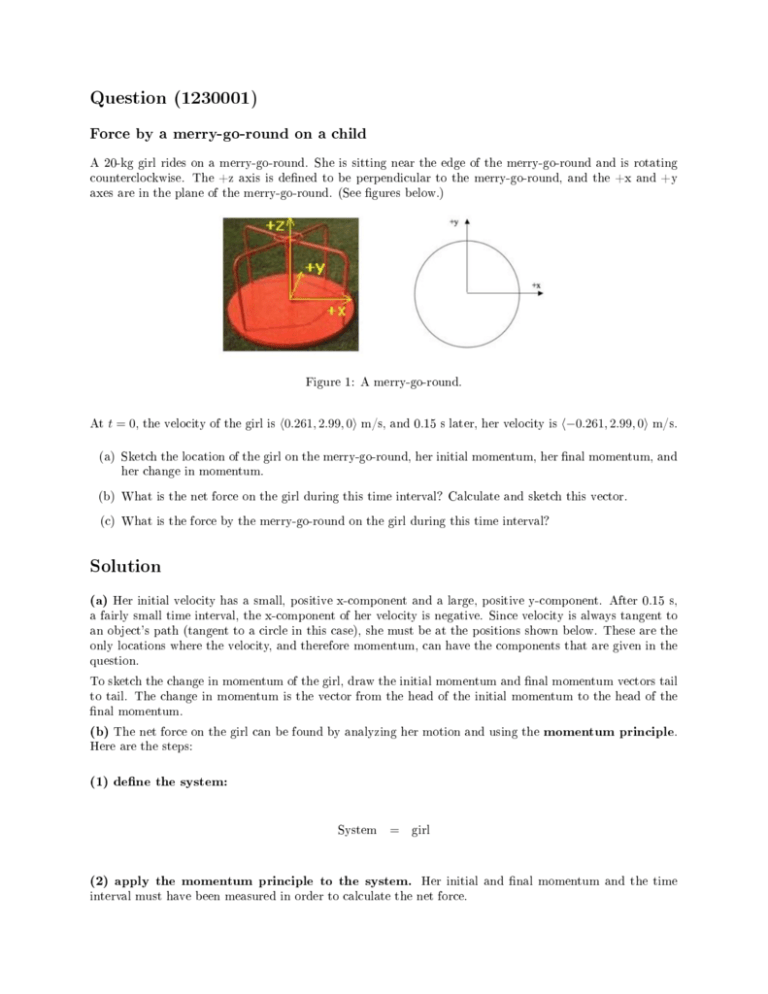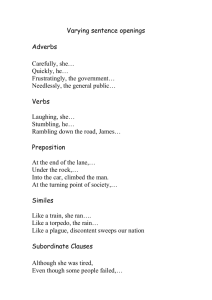Question (1230001) Solution
advertisement

Question (1230001) Force by a merry-go-round on a child A 20-kg girl rides on a merry-go-round. She is sitting near the edge of the merry-go-round and is rotating counterclockwise. The +z axis is dened to be perpendicular to the merry-go-round, and the +x and +y axes are in the plane of the merry-go-round. (See gures below.) Figure 1: A merry-go-round. At t = 0, the velocity of the girl is h0.261, 2.99, 0i m/s, and 0.15 s later, her velocity is h−0.261, 2.99, 0i m/s. (a) Sketch the location of the girl on the merry-go-round, her initial momentum, her nal momentum, and her change in momentum. (b) What is the net force on the girl during this time interval? Calculate and sketch this vector. (c) What is the force by the merry-go-round on the girl during this time interval? Solution (a) Her initial velocity has a small, positive x-component and a large, positive y-component. After 0.15 s, a fairly small time interval, the x-component of her velocity is negative. Since velocity is always tangent to an object's path (tangent to a circle in this case), she must be at the positions shown below. These are the only locations where the velocity, and therefore momentum, can have the components that are given in the question. To sketch the change in momentum of the girl, draw the initial momentum and nal momentum vectors tail to tail. The change in momentum is the vector from the head of the initial momentum to the head of the nal momentum. (b) The net force on the girl can be found by analyzing her motion and using the momentum principle. Here are the steps: (1) dene the system: System = girl (2) apply the momentum principle to the system. Her initial and nal momentum and the time interval must have been measured in order to calculate the net force. Figure 2: The initial momentum and nal momentum of a girl on the merry-go-round. Figure 3: The change in momentum of a girl on the merry-go-round. ∆~ p = F~net ∆t ∆~ p F~net = ∆t m∆~v ~ Fnet = ∆t m(~ vf − ~vi ) F~net = ∆t Substitute the given quantities F~net m(~vf − ~vi ) ∆t (20 kg)(h−0.261, 2.99, 0i − h0.261, 2.99, 0i) m/s = 0.15 s (20 kg)(h−0.522, 0, 0i) m/s = 0.15 s = h−69.6, 0, 0iN = Check your answer. Note that the net force points to the left, in the x direction. This is consistent with the direction of the change in momentum from our picture. Figure 4: The net force on the girl is in the same direction as her change in momentum. (c) To calculate an individual force acting on the system, you must apply the denition of net force as the vector sum of all forces acting on the system. Here are the steps: (1) List the objects in the surroundings that exert forces on the system. This list includes any objects that make contact with the system and any objects that exert force at a distance" such as a gravitational force or an electrostatic force or a magnetic force, for example. Here are the objects in the surroundings that exert forces on the system. interactions: girl air (which is negligible for massive objects at low speeds) merry-go-round Earth (via gravitational force) (2) Sketch a force diagram showing the forces acting on the object with approximate magnitudes and directions if they are known. Note that gravitational and electrostatic forces always act toward the source of the force. Air resistance always acts opposite the velocity. Forces due to contact with an object in the surroundings always have a component perpendicular to the surfaces in contact and often have a component parallel to the surfaces in contact (i.e. friction). In this case, the only signicant forces on the girl are the gravitational force of Earth on the girl and the force by the merry-go-round due to contact with the girl. A side view of a force diagram for the girl is shown below. Note that the force by the merry-go-round on the girl must be in the direction shown so that when adding the vectors tail to head, the resultant (or net force) is in the direction given by the momentum principle. Verify that the forces in the force diagram sum to give the correct net force. Figure 5: The force diagram showing the forces on the girl, from the side view. Figure 6: The sum of the forces on the girl give the correct net force. (3) Apply the denition of net force and solve for the unknown force. Sometimes you have to do this in component form and sometimes you can do it in vector form. We will do it both ways. First, in vector form. F~net F~by mgr on girl = F~grav by Earth on girl + F~by mgr = F~net − F~grav by Earth on girl on girl = (h−69.6, 0, 0iN) − (20 kg)(< 0, 0, −9.8 > N/kg) = (h−69.6, 0, 0iN) − (< 0, 0, −196 > N) = h−69.6, 0, 196iN Note that the force by the merry-go-round on the girl points to the left and upward (in the +z direction) exactly as shown in our force diagram. Now, let's show how to do the same calculation in component form. Sometimes solving the problem this way is required. Also, it can be instructive to see which force components might cancel out. in the x-direction Fnet,x Fby mgr on girl, x = Fgrav by Earth on girl, x = Fnet,x − Fgrav + Fby mgr on girl, x by Earth on girl, x = (−69.6N) − 0 = −69.6N Thus, the merry-go-round alone provides the net force on the girl that is to the left during this time interval. in the z-direction Fnet,z Fby mgr on girl, z = Fgrav by Earth on girl, z = Fnet,z − Fgrav + Fby mgr on girl, z by Earth on girl, z = 0 − (−196) N = 196N Thus, in the z-direction, the upward force by the merry-go-round on the child balances the downward gravitational force by Earth on the child, so that the net force in the z-direction is zero. The merry-go-round pushes upward with the same magnitude force as Earth pulls downward. As a result, the child will not move upward or downward during this time interval, but will remain on the merry-go-round (thank goodness!). You can combine the components of the force by the merry-go-round on the girl and write it in vector form. F~by mgr on girl = h−69.6, 0, 196iN









